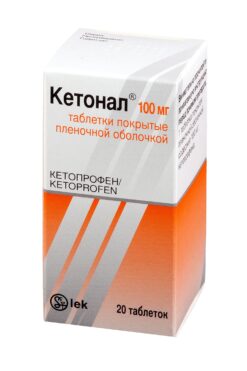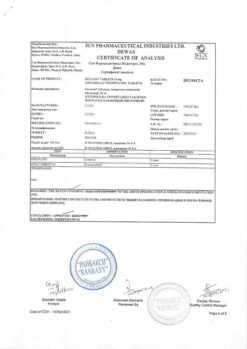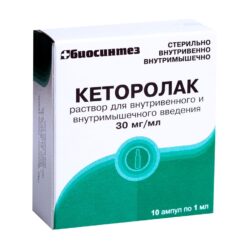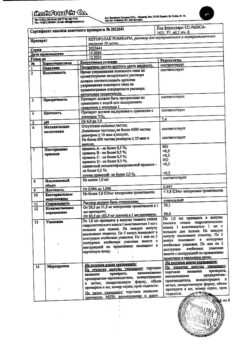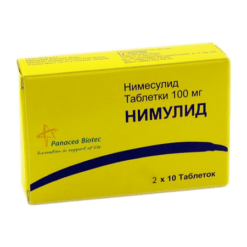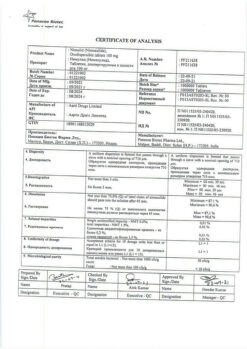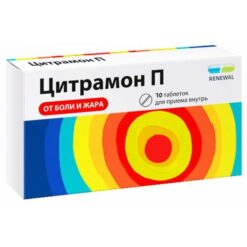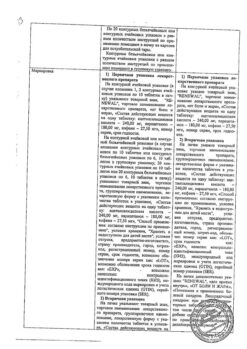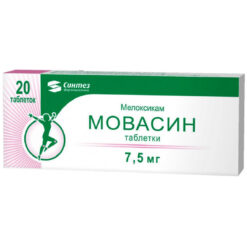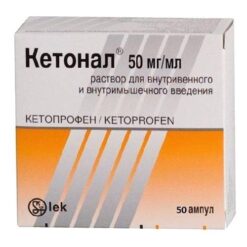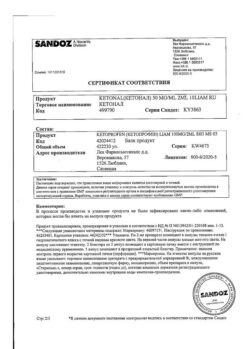No products in the cart.
Etoriax, 90 mg 7 pcs.
€1.00
Out of stock
(E-mail when Stock is available)
Description
Symptomatic therapy for osteoarthritis, rheumatoid arthritis, ankylosing spondylitis, pain and inflammation associated with acute gouty arthritis.
Short-term therapy for moderate acute pain after dental surgery.
Active ingredient
Active ingredient
Composition
Composition
1 film-coated tablet contains:
Core:
Active substance:
Etoricoxib 90.00 mg
Associates: microcrystalline cellulose, type KG-802, microcrystalline cellulose, type PH-200 LM, calcium hydrophosphate, croscarmellose sodium, sodium stearyl fumarate, colloidal silica
Film coating: Opadray 85F28751 II white* (polyvinyl alcohol, titanium dioxide (E171), macrogol-3000, talc), iron oxide red dye (E172).
* Opadray 85F28751 II white is a ready-to-use dry mixture of polyvinyl alcohol, titanium dioxide (E171), macrogol-3000 and talc.
How to take, the dosage
How to take, the dosage
Orally, regardless of the time of meals, with a small amount of water.
The drug Etoriax should be used in the lowest effective dose for the shortest possible course.
Osteoarthritis
The recommended dose is 30 mg once daily or 60 mg once daily.
Rheumatoid arthritis and ankylosing spondylitis
The recommended dose is 60 mg or 90 mg once daily. The minimum effective daily dose is 60 mg once daily. In some patients, taking 90 mg once daily may increase the therapeutic effect.
In conditions accompanied by acute pain, Etoriax should be used only in the acute symptomatic period.
Acute gouty arthritis
The recommended dose in the acute period is 120 mg once daily. The duration of use of the drug in a dose of 120 mg is not more than 8 days.
Acute pain after dental surgery
The recommended dose is 90 mg once daily. In the treatment of acute pain after dental surgery, Etoriax should be used only in the acute period for not more than 3 days.
Doses higher than those recommended for each indication either have no additional efficacy or have not been studied. Thus:
– daily dose in osteoarthritis should not exceed 60 mg;
– daily dose in rheumatoid arthritis should not exceed 90 mg;
– daily dose in ankylosing spondylitis should not exceed 90 mg;
– daily dose in acute gouty arthritis should not exceed 120 mg; for a period not to exceed 8 days;
– daily dose for pain relief after dental surgery should not exceed 90 mg; for a period not exceeding 3 days.
Special patient groups
Elderly patients
Dose adjustment in elderly patients is not necessary. As with other drugs in elderly patients, caution should be exercised when using Etoriax (see “Cautionary Note”).
Liver function impairment
Regardless of the indication, patients with mild liver dysfunction (Child-Pugh score 5-6) should not exceed a dose of 60 mg once daily; patients with moderate liver dysfunction (Child-Pugh score 7-9) should not exceed 30 mg once daily.
Caution is recommended when using etoricoxib in patients with moderate hepatic impairment because clinical experience with etoricoxib in this group of patients is limited. Due to the lack of clinical experience with etoricoxib in patients with severe hepatic impairment (⥠10 points on the Child-Pugh score), etoricoxib is contraindicated for this group of patients (see section “Pharmacological properties”, subsection “Pharmacokinetics” and sections “Contraindications” and “Special indications”).
Renal dysfunction
Dose adjustment in patients with CK ⥠30 ml/min is not required (see section “Pharmacological properties”, subsection “Pharmacokinetics”). The use of etoricoxib in patients with CKR < 30 ml/min is contraindicated (see sections “Contraindications” and “Special Precautions”).
Children
Etoricoxib is contraindicated for use in children and adolescents younger than 16 years (see “Contraindications” section).
Interaction
Interaction
Pharmacodynamic interaction
Anticoagulants for oral administration (warfarin)
In patients receiving warfarin, administration of etoricoxib at a dose of 120 mg daily was accompanied by an approximately 13% increase in the international normalized ratio (MHO) prothrombin time. In patients receiving oral anticoagulants, prothrombin time and MHO should be monitored at the start of treatment or when treatment with etoricoxib is changed, especially in the first few days.
Diuretics, angiotensin-converting enzyme (ACE) inhibitors, and angiotensin receptor antagonists II (ARAs II)
NSAIDs may weaken the effects of diuretics and other hypotensive drugs. In some patients with impaired renal function (e.g., patients with dehydration or elderly patients with impaired renal function) concomitant use of ACE inhibitor or ARA II and COX-inhibiting drugs may lead to additional impairment of renal function including possible development of acute renal failure which is usually reversible. It should be remembered about the possibility of such interactions in patients who take etoricoxib simultaneously with ACE inhibitors or with ARA II. Such a combination should be administered with caution, especially in elderly patients. At the beginning of combined treatment, as well as at certain intervals thereafter, fluid replacement and renal function monitoring should be performed.
Acetylsalicylic acid
In a study involving healthy volunteers, etoricoxib at a dose of 120 mg daily at equilibrium did not affect the antiplatelet activity of acetylsalicylic acid (81 mg once daily). Etoricoxib can be used concomitantly with acetylsalicylic acid in low doses designed for prevention of CC diseases. However, concomitant administration of low doses of acetylsalicylic acid and etoricoxib may result in an increased incidence of GI ulcers and other complications compared with etoricoxib administration alone. Concomitant use of etoricoxib with acetylsalicylic acid in doses higher than those recommended for prevention of CC complications, as well as with other NSAIDs is not recommended (see section “Pharmacological properties”, subsection “Pharmacodynamics”, as well as section “Cautions”).
Cyclosporine and tacrolimus
The interaction of etoricoxib with these drugs has not been studied, but concomitant use of NSAIDs with cyclosporine and tacrolimus may increase the nephrotoxic effect of these drugs. When concomitant use of etoricoxib with any of these drugs, renal function should be monitored.
Pharmacokinetic interaction
Influence of etoricoxib on other drugs
Lithium
NSAIDs decrease renal excretion of lithium and therefore increase plasma lithium concentrations. If necessary, frequent monitoring of lithium concentration in blood is carried out and the lithium dose is adjusted during concomitant use with NSAIDs, as well as when NSAIDs are withdrawn.
Metotrexate
Two studies examined the effects of etoricoxib at doses of 60 mg, 90 mg, and 120 mg once daily for seven days in patients receiving once-weekly methotrexate at doses ranging from 7.5 mg to 20 mg for rheumatoid arthritis. Etoricoxib at doses of 60 mg and 90 mg had no effect on plasma concentrations and renal clearance of methotrexate. In one study, etoricoxib at a dose of 120 mg had no effect on the pharmacokinetic parameters of methotrexate. In another study, plasma concentrations of methotrexate were increased by 28% and renal clearance of methotrexate was decreased by 13%. When concomitant use of etoricoxib and methotrexate should be monitored for possible toxic effects of methotrexate.
Contraceptives for oral administration
Taking etoricoxib for 21 days at a dose of 60 mg with oral contraceptives containing 35 µg ethinylestradiol (EE) and 0.5 mg to 1 mg of norethindrone increases the AUC0-24h for EE by 37%. Taking etoricoxib at a dose of 120 mg with the above oral contraceptives (simultaneously or 12 hours apart) increases the equilibrium AUC0-24h for EE by 50-60%. This increase in AE concentration should be taken into account when selecting an appropriate oral contraceptive for concomitant use with etoricoxib. This fact may lead to an increased incidence of adverse events associated with oral contraceptive use (e.g., venous thromboembolism in women at risk).
Hormone replacement therapy (HRT)
The use of etoricoxib at a dose of 120 mg concomitantly with hormone replacement therapy containing conjugated estrogens at a dose of 0.625 mg for 28 days increased the mean equilibrium AUC0-24h of unconjugated estrone (41%), equiline (76%), and 17-β-estradiol (22%). The effects of the doses of etoricoxib recommended for long-term use (30 mg, 60 mg, and 90 mg) have not been studied. Etoricoxib at a dose of 120 mg changed the exposure (AUC0-24h) of these estrogenic components less than twice as much as monotherapy with a drug containing conjugated estrogens when the latter dose was increased from 0.625 mg to 1.25 mg. The clinical significance of such increases is unknown. The use of a combination of etoricoxib and a drug containing higher doses of conjugated estrogens has not been studied. Elevated estrogen concentrations should be considered when choosing a hormonal drug for use in postmenopause when concomitantly administered with etoricoxib because increased estrogen exposure may increase the risk of OHF-related adverse events.
Prednisone/prednisolone
In drug interaction studies, etoricoxib had no clinically significant effect on the pharmacokinetics of prednisone/prednisolone.
Digoxin
When etoricoxib was administered at a dose of 120 mg once daily for 10 days in healthy volunteers, there was no change in AUC0-24h at equilibrium or effect on digoxin renal excretion. There was an increase in Cmax of digoxin (approximately 33%). This increase is generally not significant in most patients. However, concomitant use of etoricoxib and digoxin should be monitored in patients at high risk of digoxin toxicity.
The effect of etoricoxib on drugs metabolized by sulfotransferases
Etoricoxib is an inhibitor of human sulfotransferase (specifically SULT1E1) and may increase serum EE concentrations. Due to the fact that currently insufficient data on the effects of various sulfotransferases have been obtained and their clinical relevance for the use of many drugs is still being studied, it is advisable to prescribe etoricoxib with caution simultaneously with other drugs metabolized mainly by human sulfotransferases (for example, salbutamol for oral administration and minoxidil).
The effect of etoricoxib on drugs metabolized by cytochrome system isoenzymes
Based on in vitro studies, etoricoxib is not expected to inhibit cytochrome P450 isoenzymes 1A2, 2C9, 2C19, 2D6, 2E1 and 3A4. In a study involving healthy volunteers, daily use of etoricoxib at a dose of 120 mg had no effect on hepatic CYP3A4 isoenzyme activity, according to the erythromycin breath test.
Effects of other drugs on the pharmacokinetics of etoricoxib
The main metabolic pathway of etoricoxib depends on enzymes of the cytochrome system. The CYP3A4 isoenzyme contributes to the metabolism of etoricoxib under in vivo conditions. Studies in vitro suggest that the CYP2D6, CYP2C9, CYP1A2 and CYP2C19 isoenzymes may also catalyze the main metabolic pathway, but their quantitative characteristics under in vivo conditions have not been studied.
Ketoconazole
Ketoconazole is a potent inhibitor of CYP3A4 isoenzyme. When administered to healthy volunteers at a dose of 400 mg once daily for 11 days, ketoconazole had no clinically significant effect on the pharmacokinetics of a single dose of etoricoxib 60 mg (increased AUC by 43%).
Voriconazole and myconazole
Simultaneous use of strong CYP3A4 isoenzyme inhibitors (oral voriconazole or topical myconazole, oral gel) and etoricoxib caused a slight increase in etoricoxib exposure, which was not considered clinically significant based on published data.
Rifampicin
The concomitant use of etoricoxib and rifampicin (a potent inducer of the cytochrome system) resulted in a 65% decrease in plasma etoricoxib concentrations. This interaction may be accompanied by relapse of symptoms when concomitant use of etoricoxib with rifampicin. These data may indicate the need to increase the dose; however, etoricoxib should not be used in doses that exceed those recommended for each indication (see section “Dosage and administration”), since the combined use of rifampicin and etoricoxib in such doses has not been studied.
Antacids
Antacids have no clinically significant effect on the pharmacokinetics of etoricoxib.
Special Instructions
Special Instructions
Caution should be exercised when using the drug in the following patient groups:
– patients at increased risk of GI complications due to NSAIDs, elderly patients taking other NSAIDs, including acetylsalicylic acid, simultaneously, or patients with a history of GI disorders such as peptic ulcer disease and gastrointestinal bleeding;
-patients with a history of cardiovascular risk factors, such as dyslipidemia/hyperlipidemia, diabetes, arterial hypertension, smoking, heart failure, left ventricular dysfunction, edema and fluid retention;
– patients with mild liver dysfunction (5-6 Child-Pugh scores) should not exceed a dose of 60 mg once daily, patients with moderate liver dysfunction (7-9 Child-Pugh scores) 30 mg once daily;
– dehydration patients;
-patients with impaired renal function concurrently using ACE inhibitors, diuretics, angiotensin II receptor antagonists, especially elderly patients;
– patients with CK < 60 ml/min;
– patients with a previous significant decrease in renal function, with impaired renal function, decompensated heart failure or cirrhosis, who are at risk for long-term NSAID use.
Caution should be exercised with concomitant therapy with the following drugs:
– anticoagulants (eg, warfarin);
– antiaggregants (eg, acetylsalicylic acid, clopidogrel);
– drugs metabolized by sulfotransferases.
Etoricoxib is contraindicated for use in children and adolescents under 16 years of age.
Elderly patients
Dose adjustment in elderly patients is not required. As with other drugs in elderly patients, caution should be exercised when using Etoriax.
Hepatic dysfunction
Regardless of the indication, patients with mild liver dysfunction (Child-Pugh score 5-6) should not exceed a dose of 60 mg once daily; patients with moderate liver dysfunction (Child-Pugh score 7-9) should not exceed 30 mg once daily.
Caution is recommended when using etoricoxib in patients with moderate hepatic impairment because clinical experience with etoricoxib in this group of patients is limited. Due to the lack of clinical experience of etoricoxib use in patients with severe liver dysfunction (⥠10 points by Child-Pugh score) etoricoxib is contraindicated for this group of patients.
Kidney function impairment
Dose adjustment in patients with CK ⥠30 ml/min is not required. The use of etoricoxib in patients with CK < 30 ml/min is contraindicated.
Influence on the gastrointestinal tract
Cases of upper gastrointestinal complications (perforations, ulcers, or bleeding), sometimes fatal, have been reported in patients who received etoricoxib.
Caution is recommended when treating patients at high risk of GI complications when using NSAIDs, particularly elderly patients, patients who concomitantly use other NSAIDs, including acetylsalicylic acid, and patients with a history of GI disease such as ulcers or gastrointestinal bleeding.
There is an additional risk of GI adverse reactions (gastrointestinal ulcers or other GI complications) with concomitant use of etoricoxib and acetylsalicylic acid (even at low doses). In long-term clinical trials, there were no significant differences in gastrointestinal safety when using selective COX-2 inhibitors in combination with acetylsalicylic acid compared to the use of NSAIDs in combination with acetylsalicylic acid (see section “Pharmacological properties”, subsection “Pharmacodynamics”).
Influence on the cardiovascular system
The results of clinical studies suggest that the use of drugs from the class of selective COX-2 inhibitors is associated with an increased risk of thrombotic events (especially myocardial infarction and stroke) relative to placebo and some NSAIDs. Since the risk of SS disease with selective COX-2 inhibitors may increase with increasing dose and duration of use, it is necessary to choose the shortest possible duration of use and the lowest effective daily dose. The patient’s need for symptomatic treatment and response to therapy should be periodically evaluated, especially for patients with osteoarthritis (see section “Pharmacological properties”, subsection “Pharmacodynamics” as well as sections “Contraindications”, “Administration and doses” and “Side effects”).
Patients with known risk factors for CC complications (such as arterial hypertension, hyperlipidemia, diabetes mellitus, smoking) should prescribe etoricoxib only after careful assessment of benefits and risks (see section “Pharmacological properties”, subsection “Pharmacodynamics”).
Selective COX-2 inhibitors are not a substitute for acetylsalicylic acid in the prevention of CC diseases because they do not affect platelets. Therefore, the use of antiplatelet agents should not be discontinued (see section “Pharmacological properties”, subsection “Pharmacodynamics” and section “Interaction with other medicinal products”).
Influence on renal function
Renal prostaglandins may play a compensatory role in maintaining renal perfusion. In the presence of conditions that adversely affect renal perfusion, the use of etoricoxib may cause decreased prostaglandin formation and decreased renal blood flow, and thereby reduce renal function. The greatest risk of developing this reaction is in patients with a significant decrease in renal function, decompensated heart failure, or a history of cirrhosis. In such patients renal function should be monitored.
Fluid retention, edema, and arterial hypertension
As with other drugs that inhibit prostaglandin synthesis, fluid retention, edema, and arterial hypertension were observed in patients using etoricoxib. The use of all NSAIDs, including etoricoxib, may be associated with the occurrence or recurrence of chronic heart failure. Information about the dose-dependent effect of etoricoxib is given in section “Pharmacological properties”, subsection “Pharmacodynamics”. Caution should be exercised when prescribing etoricoxib in patients with a history of heart failure, left ventricular dysfunction or arterial hypertension, as well as in patients with pre-existing edema due to any other reason. If there are clinical signs of worsening in such patients, appropriate measures should be taken, including discontinuation of etoricoxib.
The use of etoricoxib, especially in high doses, may be associated with more frequent and severe arterial hypertension than with some other NSAIDs and COX-2 selective inhibitors. During treatment with etoricoxib, special attention should be paid to BP control (see section “Contraindications”), which should be monitored for 2 weeks after the start of treatment and periodically thereafter. If there is a significant increase in BP, alternative treatment should be considered.
Influence on liver function
In clinical trials lasting up to one year, approximately 1% of patients treated with etoricoxib at doses of 30 mg, 60 mg, and 90 mg per day experienced increases in ALT and/or ACT activity (approximately three or more times the upper limit of normal).
All patients with symptoms and/or signs of liver dysfunction, as well as patients with abnormal liver function parameters should be monitored.
In case of persistent liver function abnormalities (three times the upper limit of normal), etoricoxib should be discontinued.
General instructions
If the patient experiences deterioration of any of the organ systems mentioned above during treatment, appropriate measures should be taken and etoricoxib withdrawal should be considered. Appropriate medical monitoring is necessary when using etoricoxib in elderly patients and in patients with impaired renal, hepatic or cardiac function.
Treatment with etoricoxib should be initiated with caution in patients with dehydration. Rehydration is recommended before starting etoricoxib administration.
During post-marketing surveillance during the use of NSAIDs and some selective COX-2 inhibitors, serious skin reactions were very rarely reported. Some of them (including exfoliative dermatitis, Stevens-Johnson syndrome and toxic epidermal necrolysis) were fatal (see section “Adverse effects”). The risk of such reactions is highest at the beginning of therapy, in most cases during the first month of treatment. Serious hypersensitivity reactions, such as anaphylaxis and angioedema, have been reported in patients receiving etoricoxib (see section “Adverse effects”). The use of some selective COX-2 inhibitors was accompanied by an increased risk of skin reactions in patients with a history of any drug allergy. Etoricoxib should be discontinued at the first appearance of skin rash, mucosal lesions or any other sign of hypersensitivity.
The use of etoricoxib may mask fever or other signs of inflammation.
Caution should be exercised when using etoricoxib concomitantly with warfarin or other oral anticoagulants (see section “Interaction with other medicinal products”).
The use of etoricoxib, as well as other drugs that inhibit COX and prostaglandin synthesis, is not recommended for women who plan pregnancy (see section “Pharmacological properties”, subsection “Pharmacodynamics” and section “Use in pregnancy and during breastfeeding”).
Patients who have experienced dizziness, drowsiness or weakness while using etoricoxib should refrain from driving or operating machinery.
Synopsis
Synopsis
Tablets 30 mg:
Round, slightly biconvex tablets, film-coated white or almost white, with bevel.
Breakage appearance: white or almost white rugged mass with white or almost white film coating.
Tablets 60 mg:
Round, biconvex, film-coated tablets, light brownish-yellow, beveled, with “60” engraved on one side.
Breakage appearance: white or almost white rough mass with light brownish-yellow film coating.
Tablets 90 mg:
Round, biconvex, film-coated tablets in pink, beveled, with “90” engraved on one side.
Breakage appearance: white or almost white rough mass with a pink film coating.
Tablets 120 mg:
Round, slightly biconvex, film-coated, brownish-red tablets, beveled, with a bevel on one side.
Breakage appearance: white or almost white rugged mass with brownish-red film coating .
Contraindications
Contraindications
Caution should be exercised when using the drug in the following patient groups:
Side effects
Side effects
The safety of etoricoxib was evaluated in clinical trials involving 9,295 participants, including 6,757 patients with OA, RA, chronic low back pain and ankylosing spondylitis (approximately 600 patients with OA or RA were treated for 1 year or longer).
In clinical trials, the adverse effect profile was similar in patients with OA or RA who took etoricoxib for 1 year or longer.
In a clinical trial of acute gouty arthritis, patients received etoricoxib at a dose of 120 mg/day for 8 days. The adverse effect profile in this study was generally the same as in the pooled studies of OA, RA and chronic low back pain.
In the SS Safety Assessment Program, which included data from three active-controlled studies, 17412 patients with OA or RA received etoricoxib at a dose of 60 mg or 90 mg for an average of 18 months (see Pharmacological Properties, subsection “Pharmacodynamics”).
In clinical trials of acute postoperative pain associated with dental surgery in which 614 patients received etoricoxib at a dose of 90 mg or 120 mg, the adverse effect profile was generally similar to that in pooled studies of OA, RA and chronic low back pain.
The following adverse reactions have been reported with greater frequency with etoricoxib than with placebo in clinical trials involving patients with OA, RA, chronic low back pain or ankylosing spondylitis who were taking etoricoxib at a dose of 30 mg, 60 mg, or 90 mg with dose escalation over 12 weeks, in MEDAL studies lasting up to 3.5 years, in short-term acute pain studies, and in postmarketing use.
Class system/organ
Impossible
Frequency1
infectious and parasitic diseases
alveolar ostitis
often
gastroenteritis, upper respiratory tract infections, urinary tract infections
not often
Blood and lymphatic system disorders
anemia (mainly due to gastrointestinal bleeding), leukopenia, thrombocytopenia
not often
immune system disorders
hypersensitivity reactions2.4
not often
angioedema, anaphylactic/anaphylactoid reactions including shock2
rare
Disorders of metabolism and nutrition
fluid swelling/inhibition
often
decreased or increased appetite, increased body weight
not often
Mental disorders
anxiety, depression, concentration disorders, hallucinations2
not often
confusion2, anxiety2
rare
Nervous system disorders
dizziness, headache
often
taste disorders, insomnia, paresthesia/hypoesthesia, sleepiness
not often
VIight organ disorders
blurred vision, conjunctivitis
not often
Hearing organ and labyrinth disorders
tinnitus, vertigo
not often
Cardiac disorders
heart palpitations, arrhythmia2
often
atrial fibrillation, tachycardia2, chronic heart failure, nonspecific electrocardiogram (ECG) changes, angina2, myocardial infarction5
not often
vascular disorders
hypertension
often
“flushes,” impaired cerebral circulation5, transient ischemic attack, hypertensive crisis2, vasculitis2
not often
Disorders of the respiratory system, thorax and mediastinum organs
bronchospasm2
often
cough, shortness of breath, nosebleed
not often
digestive system disorders
abdominal pain
very often
constipation, flatulence, gastritis, heartburn/gastroesophageal reflux, diarrhea, epigastric dyspepsia/discomfort, nausea, vomiting, esophagitis, oral mucosa ulcers
often
abdominal bloating, altered peristalsis, dry oral mucosa, gastroduodenal ulcers, peptic ulcers including gastrointestinal perforations and bleeding, irritable bowel syndrome, pancreatitis
sup>2
not often
Liver and biliary tract disorders
increased alanine aminotransferase (ALT) activity, increased aspartate aminotransferase (AST) activity
often
hepatitis2
rare
hepatic failure2, jaundice2
rarely3
dermal and subcutaneous tissue disorders
ecchymosis
often
facial swelling, skin itching, skin rash, erythema2, urticaria2
not often
Stevens-Johnson syndrome2, toxic epidermal necrolysis2, fixed drug erythema2
rarely3
Overdose
Overdose
In clinical trials, administration of etoricoxib at a single dose of up to 500 mg or multiple doses of up to 150 mg/day over 21 days did not cause significant toxic effects. Acute overdose with etoricoxib has been reported, but in most cases adverse reactions have not been reported.
The most frequent adverse reactions were consistent with the safety profile of etoricoxib (e.g., GI disturbances, cardiorenal events).
In case of overdose, the usual supportive measures such as removal of unabsorbed drug from the GI tract, clinical observation and, if necessary, supportive therapy are appropriate. Etoricoxib is not excreted by hemodialysis; excretion of etoricoxib by peritoneal dialysis has not been studied.
Pregnancy use
Pregnancy use
Pregnancy
There are no clinical data on the use of etoricoxib during pregnancy. Toxic effects on the reproductive system have been observed in animal studies. The potential risk in women during pregnancy is unknown. The use of etoricoxib, as well as other drugs that inhibit the synthesis of prostaglandins, during the last trimester of pregnancy may lead to suppression of uterine contractions and premature closure of the arterial duct. Etoricoxib is contraindicated during pregnancy (see section “Contraindications”). If pregnancy occurs during treatment, etoricoxib should be discontinued.
Breastfeeding
In lactating rats, etoricoxib is excreted with milk. There have been no studies confirming etoricoxib excretion with breast milk in women. Women who take etoricoxib should stop breastfeeding (see section “Contraindications”).
Fertility
The use of etoricoxib, as well as other drugs that inhibit COX-2 and prostaglandin synthesis, is not recommended for women who are planning a pregnancy.
Similarities
Similarities
Additional information
| Weight | 0.015 kg |
|---|---|
| Shelf life | 3 years. Do not use the product after the expiration date. |
| Conditions of storage | At the temperature not more than 25 °С, in the original package. Store out of reach of children. |
| Manufacturer | KRKA dd Novo mesto, Slovenia |
| Medication form | pills |
| Brand | KRKA dd Novo mesto |
Related products
Buy Etoriax, 90 mg 7 pcs. with delivery to USA, UK, Europe and over 120 other countries.


